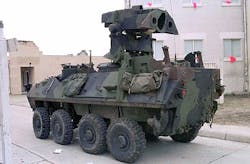Raytheon moving forward on upgrading Marine Corps LAV armored vehicle with anti-tank missile
Officials of the Army Contracting Command in Warren, Mich., on Wednesday announced a $30.1 million contract modification to the Raytheon Co. Missile Systems segment in McKinney, Texas, to build 20 new LAV anti-tank turrets, which will enable Marine Corps LAV crews to fire the Raytheon tube-launched, optically tracked, wireless-guided (TOW) anti-armor missile.
Raytheon will provide the LAV anti-tank version (LAV-AT) with an improved thermal sight and advanced fire-control system to enable the combat vehicle to acquire targets while on the move, fire current and next-generation heavy anti-armor missiles, and provide multi-shot capability.
These improvements are expected to improve the reliability, availability, maintainability, supportability, and mission effectiveness of the LAV-AT.
Wednesday's $30.1 million contract modification is an addition to Raytheon's original $19.7 million contract, which was awarded in April 2012, for the engineering and manufacturing development (EMD) phase of the LAV-AT Modernization Program.
With this contract the Marine Corps will have received nearly 90 of an expected 118 upgraded light armored vehicles that are able to fire the advanced TOW armor- and tank-killing missile.
Raytheon also won a $32.7 million modification to this contract last December to upgrade the missile turrets on 22 Marine Corps LAVs; a $56.4 million modification in June 2015 to upgrade 34 Marine Corps LAV turrets; and a $19.3 million contract modification in August 2014 for 13 Marine Corps LAV anti-tank modernization turrets.
This program is designed to counter two converging obsolescence issues on the LAV-AT, Army officials say. First, the M901 Emerson turret is no longer in production and has been retired from the U.S. Army inventory. Second, the M220A3 TOW system is being replaced by the M41 SABER system in the infantry and the tank battalions of the Marine Corps.
Related: Raytheon upgrading anti-tank missile on Marine Corps light armored vehicle (LAV) fleet
Ultimately the program seeks to acquire 118 anti-tank weapon systems for the Marine Corps LAV-AT combat vehicles. The Army is handling this procurement for the Marine Corps.
Raytheon is building the anti-tank weapon systems for the LAV-AT combat vehicles in McKinney, Texas, and the systems will be installed on the vehicles at Marine Corps maintenance centers. Work on this order should be finished by February 2019.
The anti-tank weapon system on the LAV-AT rises out of the vehicle's hull when needed, and retracts inside the vehicle for protection and reloading. The system can destroy enemy armored vehicles and hardened targets.
Related: Raytheon to build radio-controlled TOW anti-tank missiles in $391.5 million contract
The LAV-AT is an eight-wheeled amphibious armored vehicle that serves Marine Corps expeditionary forces with speed, mobility, and fire power. It serves as an offensive weapon and armored personnel carrier.
For more information contact Raytheon Missile Systems online at www.raytheon.com, or the Army Contracting Command-Warren at http://contracting.tacom.army.mil.
Learn more: search the Aerospace & Defense Buyer's Guide for companies, new products, press releases, and videos

